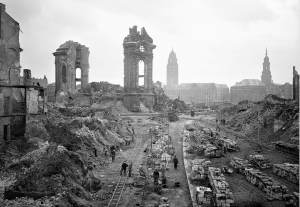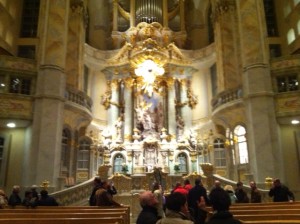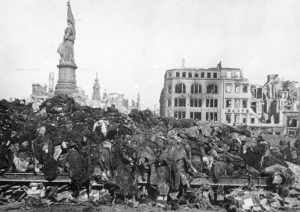These words as spoken by Sir Arthur Harris, often referred to as “Bomber” Harris or sometimes in a less friendly fashion as “Butcher” Harris, sealed the fate of one of Europe’s most beautiful cities, Dresden.
Exactly 70 years ago, over the period from 13 to 15 February, 1945, more than 700 RAF and 500 US bombers, in four raids, dropped nearly 4,000 tons of high explosive and incendiary bombs on a city that has often been referred to as “Florence on the Elbe”. By the time it was over, the bombing and the firestorm it created had decimated an area measuring more nearly 2 miles x 2 miles in the city center and killed nearly 25,000 people.
By February of 1945, area bombing, sometimes referred to as carpet bombing, was not new to the Allied effort. What was new and what has created its own “ethical firestorm” is that Dresden was known for its incredible baroque architecture and its pretty location along the banks of the Elbe. This fact, multiplied by the resulting firestorm that killed nearly 25,000 people, multiplied by its proximity to the end of the war in Europe, multiplied by well intentioned people from the UK and the US who have since made apologetic comments about the harshness of the deed, and finally multiplied by the German need to grasp upon any deed that might seem excessive by the Allies so as to allow Germans to feel that they were a “victim”, has turned the bombing of Dresden into a symbol for the suffering of German civilians during the war. A symbol for those who lived beneath a barrage of anonymous bombs dropped at night by the British RAF and by day by the US Air Force. A symbol for the deaths of perhaps 500,000 German civilians at the hands of Bomber Command, and its leader, “Bomber” Harris.

Harris took over as the Commander-in-Chief of Bomber Command in February 1942. He was promoted into the position after the British realized that their efforts to properly bomb targets up to this point had been woefully inadequate. Through the first 2 years of the war, only 1/3 of all bombers had gotten within 5 miles of their intended targets before dropping their bombs. Harris was brought in to fix it.
At the same time, Churchill’s War Cabinet had been debating how best to employ its growing force of Lancaster and Wellington bombers. Churchill’s personal scientific advisor, Professor Lindemann, had penned a policy paper that advocated carpet bombing or area bombing of German cities as a way to break the moral of the German people and hasten the end of the war. The War Cabinet adopted the plan and Harris was tasked to carry it out.
He stated at the beginning of his tenure at Bomber Command,
The Nazis entered this war under the rather childish delusion that they were going to bomb everyone else, and nobody was going to bomb them. At Rotterdam, London, Warsaw and half a hundred other places, they put their rather naive theory into operation. They sowed the wind, and now they are going to reap the whirlwind.
Harris’ initial results were also disappointing. But gradually the number and quality of the British bombers improved as did their technical abilities. At the same time, the Luftwaffe’s technical and numerical advantages were slowly overcome.
Harris was an advocate for launching huge raids on specific targets. His idea was to overwhelm the German defenses at a given location by launching 1000 plane raids against a specific target. His first 1000 plane raid was launched against Cologne on 30 May 1942 with devastating results.
With better navigational aids and new technology employed to fool the German night fighters, results continued to improve. Harris was promoted to Air Marshall. He, and many other influential high-ranking Allied commanders began to believe that their carpet bombing strategy just might force the Germans to an early surrender.
Harris boldly proclaimed pending victory against the Germans in August of 1943 after the devastating bombing of Hamburg. In the last few days of July of 1943, the British and US Air force carpet bombed Hamburg, exactly as they would carpet bomb Dresden. Perhaps 40,000 civilians died in Hamburg in a firestorm that engulfed nearly the entire city center. A vortex of super-heated air created a tornado of fire that reached up to 1500 feet into the sky. The men in the bombers had never seen this before as it was totally unexpected. The clear weather, improving skill of the Pathfinders and the use of a new radar system by the Pathfinders known as H2S all worked to make the bombing more effective. The Hamburg raid also employed, for the first time, a new innovation called “Window”. We know it today as “chaff”; small strips of aluminum dropped by the bombers and designed to interfere with German radar. The raid resulted in considerable damage to the German arms industry and was considered a huge success.
As often happens, there were unintended consequences of the raid on Hamburg. Only 15 km south of Hamburg’s city center was a concentration camp called Neuengamme. The SS opened the camp in 1938 to house political prisoners but its purpose was soon expanded to house the usual cast of Nazi targets that invariably perished in droves in camps such as this all over Germany. Jews, homosexuals, Jehovah’s Witnesses, communists, political prisoners and POW’s were all worked to death in wretched conditions at Neuengamme itself but also at dozens of sub-camps all over the area. After the Hamburg bombing, hundreds of prisoners were sent to clear the rubble and bury the dead. None of them ever returned to the camp.
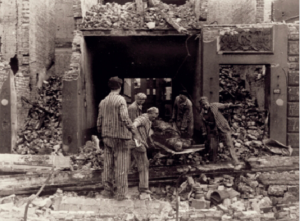
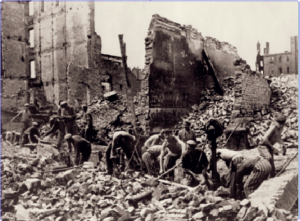
Neuengamme records show 106,000 people arriving. By wars end, 55,000 had been worked to death or simply murdered. The number that were murdered while clearing rubble in Hamburg is unknown.
Churchill was not a big fan of area bombing and his public statements during this time maintained that Bomber Command was attacking industrial targets. He said that any civilian casualties were unintentional but were unavoidable. After the success of the Hamburg raid, Harris and others urged the War Cabinet to be more honest with the public with regards to the real strategy of the bombing campaign. Notes from the War Cabinet meetings at the time indicate that Harris argued that:
the aim of the Combined Bomber Offensive…should be unambiguously stated [as] the destruction of German cities, the killing of German workers, and the disruption of civilised life throughout Germany.
… the destruction of houses, public utilities, transport and lives, the creation of a refugee problem on an unprecedented scale, and the breakdown of morale both at home and at the battle fronts by fear of extended and intensified bombing, are accepted and intended aims of our bombing policy. They are not by-products of attempts to hit factories.[
In November of 1943, Harris began attacking Berlin with 1000 plane raids in the hopes of duplicating the success of Hamburg. But Berlin was far better defended and much further away from England forcing the bombers to carry fewer bombs and more fuel for the round trip. German fighter coverage was much better over Berlin and the city itself was defended by a series of large “flak towers”. These towers proved to be virtually indestructible to bombs and held dozens of anti-aircraft guns. The RAF and USAF were unable to ignite a firestorm in Berlin but instead suffered terrible losses in aircraft. Over several months, the Allied loses exceeded 1000 bombers shot down and more than 1500 heavily damaged. Often more than 10% of the attacking force was being shot down on each raid. The losses were unsustainable with most of the damage resulting from anti-aircraft fire from the flak towers.
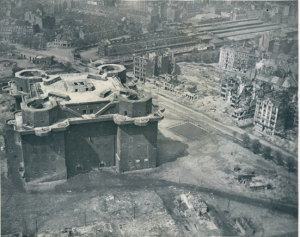
Visitors to Berlin today can still see these structures as they proved too difficult and too strong to dismantle after the war. Its possible to tour the interior as well too see for yourself the Nazi love affair with concrete and high strength carbon steel rebar.
Despite Bomber Command not being able to bring the war to a close through carpet bombing, there is no doubt that the effort had a huge impact on the Nazi war effort. After the war, Albert Speer, Hitler’s Minister of Supply wrote that were it not for the bombing campaign, up to ten thousand additional deadly 88 mm guns would have been available as anti-tank weapons on both the eastern and western fronts where they already had a reputation for cutting through allied tanks like a hot knife through butter. In recognition of this, Stalin awarded Harris the Order of Suvorov in February of 1944. The US awarded Harris the Legion of Merit in January o f 1945.
Prior to D-Day, Harris and Bomber Command were pulled off their carpet bombing mission. For a time they were given the mission of bombing French rail yards to make it more difficult for the Germans to send reinforcements to counter the coming allied invasion. But after D-Day, Bomber Command returned to the mission of area bombing over Germany to progressively cause as much destruction and dislocation of German industrial and economic centers as possible.
Ultra intercepts from Bletchley Park where the Allies, under Alan Turing’s direction, were breaking the German’s Enigma codes indicated that the Germans were beginning to suffer from serious fuel shortages. So after D-Day, Harris was told to target these facilities with some success. But the Germans were producing fuel from coal in small facilities all over Germany, even on railway cars, making it difficult to significantly impact fuel production. Eventually targeting was switched to include more and more rail yards. This proved increasingly effective at destroying the German fuel supply by making it more and more difficult to transport coal from the Ruhr to wherever the Germans had hidden the synthetic fuel manufacturing facilities.
Thus we come to February of 1945, a time during which the Russians were beginning to close on the final barrier that separated the Russian armies from Berlin, the Oder River that today separates Germany from Poland.
After the Russians crossed the Vistula and captured Warsaw on January 17, their pace of advance increased as the German armies retreated. Krakow was captures on 19 January 1945. 8 days later, on 27 January 1945, Auschwitz was liberated. The Russians soon pushed into Lower Silesia, then part of Germany, forcing thousands upon thousands of German civilians to flee to the west.
German refugees flooded across the Oder River ahead of the Russian army. Dresden, located some 200 km south of Berlin had been relatively unscathed by the war. Its rail yards were relatively intact and tens of thousands of Germans were streaming west as fast as they could to get away from the approaching Russian army.
On the night of the Dresden attack, the RAF issued the following memo to the airmen who participated:
Dresden, the seventh largest city in Germany and not much smaller than Manchester is also the largest unbombed builtup area the enemy has got. In the midst of winter with refugees pouring westward and troops to be rested, roofs are at a premium, not only to give shelter to workers, refugees, and troops alike, but to house the administrative services displaced from other areas. At one time well known for its china, Dresden has developed into an industrial city of first-class importance…. The intentions of the attack are to hit the enemy where he will feel it most, behind an already partially collapsed front… and incidentally to show the Russians when they arrive what Bomber Command can do.
The original plan was to send the USAF to Dresden during the day on 13 February 1945 but bad weather over Europe scratched the daytime raid. Thus it was left to the British to carry out the first raid that night. The plan was for a double attack. The first wave would be followed by a second wave three hours later specifically to target the fire crews who by then would be well engaged in fighting the fires from the first wave.
The first wave of 254 Lancasters hit the city at 22:14. By 22:22 the attack was complete with close of 900 tons of high explosives and incendiary bombs. The second wave of nearly 500+ Lancasters and Wellingtons hit the city at 01:21 on 14 February 1945 and dropped more than 1800 tons of bombs. (In an earlier article I describe one of my uncles as being a Pathfinder in this second wave).
Later that same day, 300+ B-17’s in two groups dropped 700 tons of bombs on Dresden beginning at 12:17 and continuing for more than hour.
Of the total of nearly 800 RAF bombers hitting Dresden, only six were lost, three of which were hit by bombers dropping bombs from higher altitudes and hitting other RAF planes below them. Only a single B-17 was lost during the daytime raids by the USAF.
On the ground, the results were devastating. The old city was engulfed in a huge firestorm. By the time the fires were extinguished, the RAF was able to conclude that one quarter of the industrial buildings and half of the rest were destroyed. Some 78000 houses and apartments were destroyed. Total deaths were around 25000 people, most of whom suffocated as the firestorm consumed all the oxygen.
Kurt Vonnegut, a US soldier during WW2, was thrown into combat during the Battle of the Bulge. Like many others, he was captured by the Germans and sent to a POW camp in Dresden where he would experience the fire bombing first hand. He survived after taking refuge in an underground slaughterhouse which the Germans had converted into prison cells. The guards called the building Schlachthof Funf (Slaughterhouse Five). After the bombing, Vonnegut was put to work by the Germans gathering up corpses from underground cellars which had not protected their occupants. Many of Vonnegut’s books are centered around his experiences in Dresden.
The firebombing of Dresden became a rallying point for people who thought the Allies and Harris had gone too far with their bombing campaign even before the war ended. Somehow the allied attack on Dresden, known by all to be a cultural gem, seemed excessive, especially to those in the intellectual circles in the UK and US. The Associated Press published an article describing the event as a terror bombing.
However you view it, this was the last city that the allies in Europe were to fire bomb. But in Japan, by wars end, 67 cities received the same treatment, only made worse by the much larger bombing capacity of the B-29 compared to the B-17 and the prevalent use of wood in Japanese construction methods. Curtis LeMay, the US General in charge of the Air Force in the Pacific, had learned from Bomber Harris.
Immediately after the war, the controversy would only increase. Churchill was replaced by Clement Attlee as Prime Minister in a new Labor government that immediately began questioning the belligerent policies of Harris and Churchill. Churchill was already speaking out against the new threat of a communist takeover of Europe. Attlee’s government tried to marginalize Churchill by using Dresden as an example of Churchill’s war mongering, a charge that the Labor party had leveled against Churchill in the 1930’s as Churchill spoke out against Hitler.
Bomber Harris retired in September of 1946 and soon published his story about Bomber Command’s achievements in the book “Bomber Offensive”.
In the book he wrote about Dresden:
I know that the destruction of so large and splendid a city at this late stage of the war was considered unnecessary even by a good many people who admit that our earlier attacks were as fully justified as any other operation of war. Here I will only say that the attack on Dresden was at the time considered a military necessity by much more important people than myself.
In a dispute with the Attlee government over awarding the members of Bomber Command with a separate medal after the war, Harris became furious and refused a peerage in 1946. He was thus the sole commander-in-chief not to become a peer. In post-war Europe, this made it seem, even more so, that the government thought Harris had “gone too far” with the bombing campaign.
When Winston Churchill was returned to office as the Prime Minister in 1953, he insisted that Harris accept a peerage and “Bomber Harris” became “Sir Arthur Harris”.
But this did not quiet the controversy. Indeed over the years it has only grown and seems to have become a source of fuel for Germans who believe that the Dresden bombing was “excessive” and therefore they too were “victims” during the war. Somehow Dresden’s fate is separated from the fate of the dozens of cities and towns and millions of civilians murdered by the Nazis.
The city has now been almost completely rebuilt to its former glory. The nearly destroyed old town has been nearly completely rebuilt with the odd exception of the Jewish synagogue, built in 1838, that stood on the edge of the old town but was burned down and destroyed not by the allied bombing but on Kristalnacht on the night of 9 November 1938. The bill for the removal of the rubble of the old synagogue was given to the Jewish community of Dresden. Its not clear if they paid it before they were subsequently murdered.
The most famous of the buildings to be rebuilt in the old town is the Frauenkirche (Church of our Lady). A German born American biologist whose family escaped from Lower Silesia through Dresden in those last closing days of the war became interested in seeing the church and other buildings rebuilt. Gunter Blobel took an active role in the 1990’s to raise money for this purpose. Blobel won the Nobel Prize in Medicine for his discovery of signal peptides in 1999. He donated the entire award towards the building of the church and of a new synagogue in Dresden.
Today the Frauenkirche has been returned to its former glory and stands as a symbol of the rebuilding of Dresden. Many of the original large stones that were knocked down in 1945 were reused in the construction of the church. These old stones are black in color compared to the lighter tan new stones.
Many of the rebuilt structures are well worth a trip to Dresden to view. In addition to the Frauenkirche, the Dresden Opera House is a must-see.
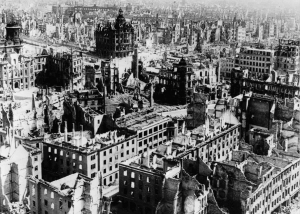
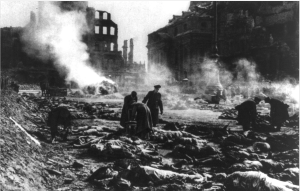
Too many to bury
